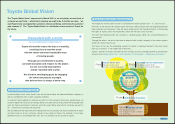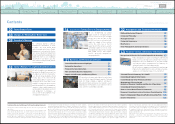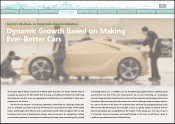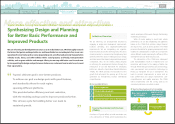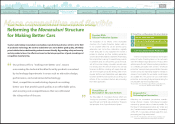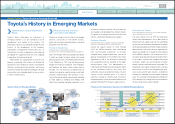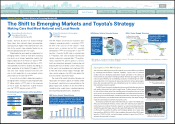Toyota 2012 Annual Report Download - page 8
Download and view the complete annual report
Please find page 8 of the 2012 Toyota annual report below. You can navigate through the pages in the report by either clicking on the pages listed below, or by using the keyword search tool below to find specific information within the annual report.
Management and
Corporate Information Investor Information
Changes for Making
Ever-Better Cars
Toyota Global Vision Business and
Performance Review
Special Feature
Medium- to Long-Term
Growth Initiatives
President
ʼ
s Message Financial Section
TOYOTA ANNUAL REPORT 2012
Contents
Changes for Making Ever-Better Cars
This document contains forward-looking statements that reflect Toyota's plans and
expectations.
These forward-looking statements are not guarantees of future performance and
involve known and unknown risks, uncertainties and other factors that may cause
Toyota's actual results, performance, achievements or financial position to be
materially different from any future results, performance, achievements or financial
position expressed or implied by these forward-looking statements. These factors
include, but are not limited to:
(
i
)
the impact of natural calamities including the negative
Cautionary Statement with Respect to Forward-Looking Statements
effect on Toyota's vehicle production and sales;
(
ii
)
changes in economic conditions
and market demand affecting, and the competitive environment in, the automotive
markets in Japan, North America, Europe, Asia and other markets in which Toyota
operates;
(
iii
)
fluctuations in currency exchange rates, particularly with respect to the
value of the Japanese yen, the U.S. dollar, the euro, the Australian dollar, the Canadian
dollar and the British pound, and interest rates fluctuations;
(
iv
)
changes in funding
environment in financial markets and increased competition in the financial services
industry;
(
v
)
Toyota's ability to market and distribute effectively;
(
vi
)
Toyota's ability to
realize production efficiencies and to implement capital expenditures at the levels and
times planned by management;
(
vii
)
changes in the laws, regulations and government
policies in the markets in which Toyota operates that affect Toyota's automotive
operations, particularly laws, regulations and government policies relating to vehicle
safety including remedial measures such as recalls, trade, environmental protection,
vehicle emissions and vehicle fuel economy, as well as changes in laws, regulations
and government policies that affect Toyota's other operations, including the outcome of
current and future litigation and other legal proceedings, government proceedings and
investigations;
(
viii
)
political and economic instability in the markets in which Toyota
operates;
(
ix
)
Toyota's ability to timely develop and achieve market acceptance of new
products that meet customer demand;
(
x
)
any damage to Toyota's brand image;
(
xi
)
Toyota's reliance on various suppliers for the provision of supplies;
(
xii
)
increases
in prices of raw materials;
(
xiii
)
Toyota's reliance on various digital and information
technologies; and
(
xiv
)
fuel shortages or interruptions in electricity, transportation
systems, labor strikes, work stoppages or other interruptions to, or difficulties in,
the employment of labor in the major markets where Toyota purchases materials,
components and supplies for the production of its products or where its products are
produced, distributed or sold.
A discussion of these and other factors which may affect Toyota's actual results,
performance, achievements or financial position is contained in Toyota's annual
report on Form 20-F, which is on file with the United States Securities and Exchange
Commission.
Special Feature: Toyota's Efforts in Emerging Markets
We are strengthening our global
supply system in emerging markets
so as to achieve an overall emerging
market sales ratio for TMC of 50%
by 2015, to achieve a system that will
enable the output of three-million
vehicles
(
the same level as that in
Japan
)
by 2013. We will proceed with
carmaking responsive to local needs
and expand sales by actively releasing
IMVs, global vehicles and compact
vehicles specifically designed for
emerging markets.
Toyota Global Vision
経営・会社情報
Management and Corporate Information
R&D and Intellectual Property
32
Corporate Philosophy
34
Corporate Governance
36
Management Team
35
Risk Factors
38
Other Management and Corporate Data
42
Financial Section and Investor Information
Business and Performance Review
Consolidated Performance Highlights
21
Automotive Operations
24
Financial Services Operations
26
Non-automotive Business Operations
27
Impact of the Disasters and Recovery Efforts
30
We continued, during a difficult
management environment, to work
to make cars that would bring
smiles to people who choose Toyota.
Management centered on the
“
better
cars
”
as described in our Global Vision
brings the profitability and production
output that starts a cycle leading to
investment in
“
ever-better cars.
”
We
shall continue to forge ahead, without
ever turning back.
President's Message
2011 was witness to major natural disasters in the form
of the Great East Japan Earthquake and the Thailand
floods. All Group companies, suppliers and dealers
affiliated with Toyota worked as one toward recovery
and production normalization, so as to deliver vehicles
to our customers as promptly as possible.
Toyota
'
s Medium- to Long-Term Growth Initiatives
We will strengthen our management
based on the Global Vision as well as
strengthen our efforts to make better
cars. We aim to quickly build a strong
revenue base in the short term by
enhancing our ability to counteract the
strong yen. At the same time, as our
medium- to long-term efforts we will
push forward with the reforming of our
corporate culture and the progress of
our development, design, procurement
and production technologies, as
well as with the development of our
emerging market business.
Reduced output due to Japanese Earthquake and Thailand
floods as well as a stronger yen resulted in lower revenues
and profits in the year ended March 31, 2012, but through
cost-reduction efforts, including fixed cost reduction, we
continued to make structural improvements.
We will continue to engage in marketing efforts and earnings
improvements, and will work to realize a strong revenue base
capable of accommodating changes in the environment.
Selected Financial Summary
(
U.S. GAAP
)
45
Consolidated Quarterly Financial Summary
48
Consolidated Financial Statements
77
Management's Annual Report on Internal Control over Financial Reporting
124
Consolidated Segment Information
47
Management's Discussion and
Analysis of Financial Condition and Results of Operations
49
Notes to Consolidated Financial Statements
82
Report of Independent Registered Public Accounting Firm
125
Investor Information
126
Message from the Executive Vice President Responsible for Accounting
43
Click any title to link to that section
0821
Search Contents NextPrev page 8


